Talking With Marc Newson: Jaeger-LeCoultre’s Favorite ‘Clock Designer’ Styles New Atmos 568
The Atmos by Jaeger-LeCoultre is undoubtedly the most exhilarating clock in the entire world thanks to the fact that it perpetually winds itself using changes in temperature in the air around it.
And it has perhaps been made even more interesting by collaborations with celebrated designer Marc Newson; the Swiss manufacture and the Australian designer have done three Atmos variations together. I had a chance to speak with Newson upon the release of his latest collaborative clock with the Le Sentier-based brand, the Atmos 568.
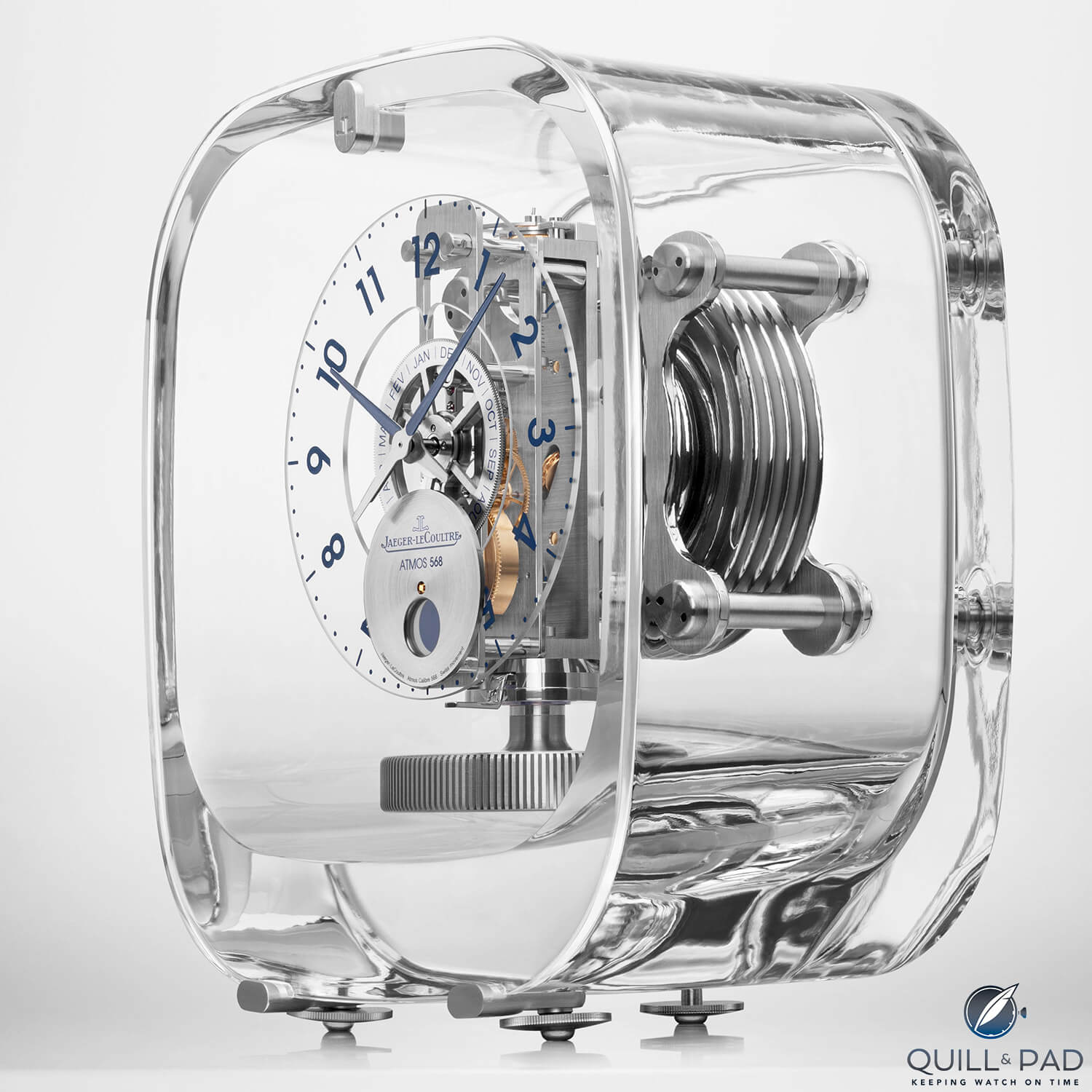
Atmos 568 by Jaeger-LeCoultre, designed by Marc Newson
Born in Australia, 54-year-old Marc Newson has tackled all areas of design, ranging from furniture to bicycles and interior design to instruments for daily living. Newson, long attracted to Jaeger-LeCoultre’s legendary clock, contacted the brand with a design – resulting in 2008’s Atmos 561.
This is a design that captures the very essence of the Atmos clock with its transparency. “I’ve been aware of the Atmos clock since I was a child and been fascinated by it for a very long time,” said Newson.
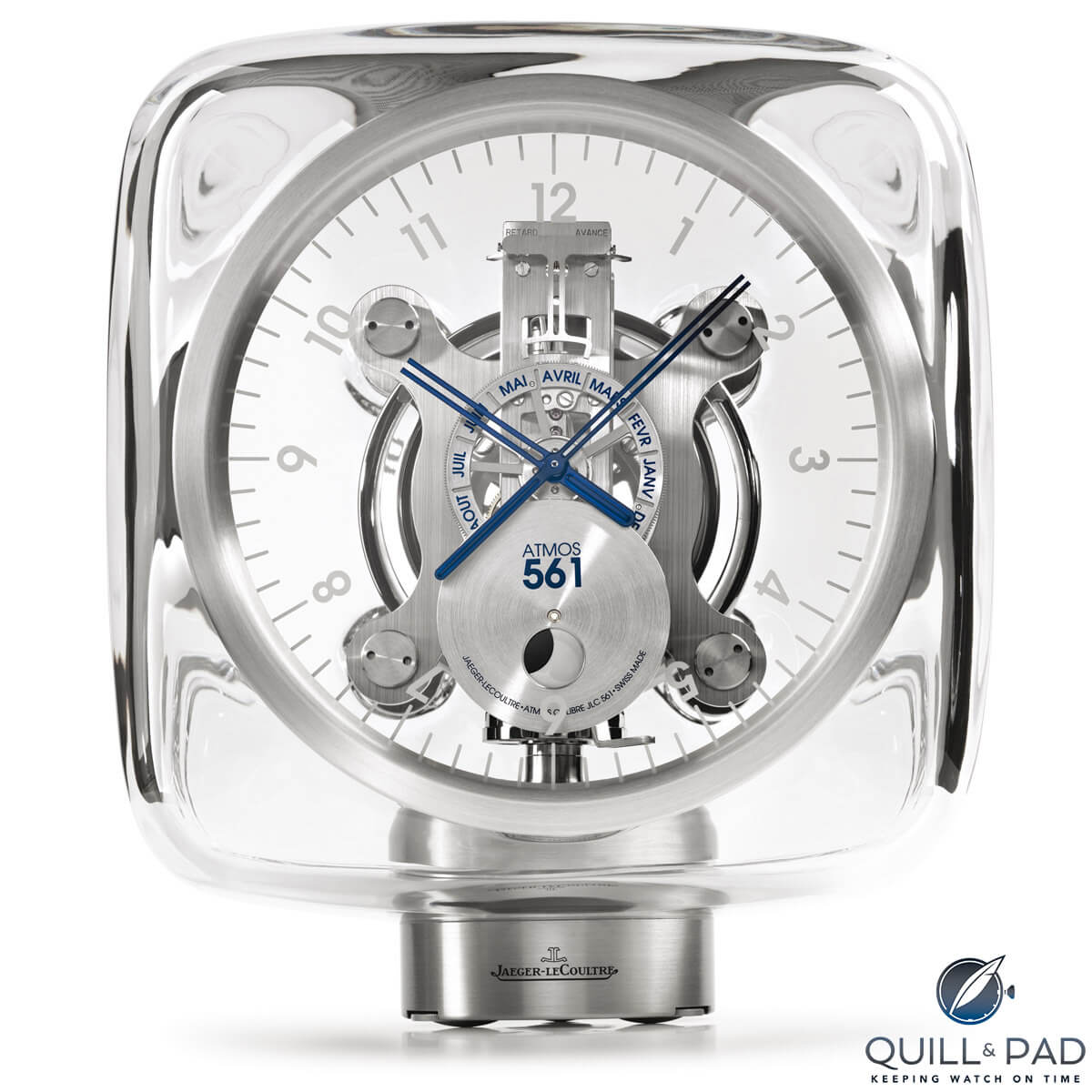
Jaeger-LeCoultre Atmos 561 by Marc Newson from 2008
The second collaborative clock, the Atmos 566, came along in 2010. “I think it’s probably worth it to point out that the first two Atmos clocks were limited editions because fundamentally they were very difficult to make,” Newson says of the Baccarat-encased timepieces. “The difference with the new 568 is that I think we’ve really now refined the ability to be able to work in crystal, having done it twice before. It is still quite a complicated thing to make, but at least it’s not limited.”
Inspired by the timeless quality of the Jaeger-LeCoultre Atmos
Newson is, to make a long story short, inspired by the timeless quality of the Atmos. “More of a source of inspiration is the fact that the mechanism was designed almost 90 years ago, and I think that fundamentally it hasn’t dated. I’ve been able to work with a truly timeless mechanism. That, in many ways, has been the inspiration.”
“It’s a completely anachronistic object because it is, of course, about time but at the same time it is completely timeless, and, I think, moving into the future it becomes potentially even more relevant,” he adds.
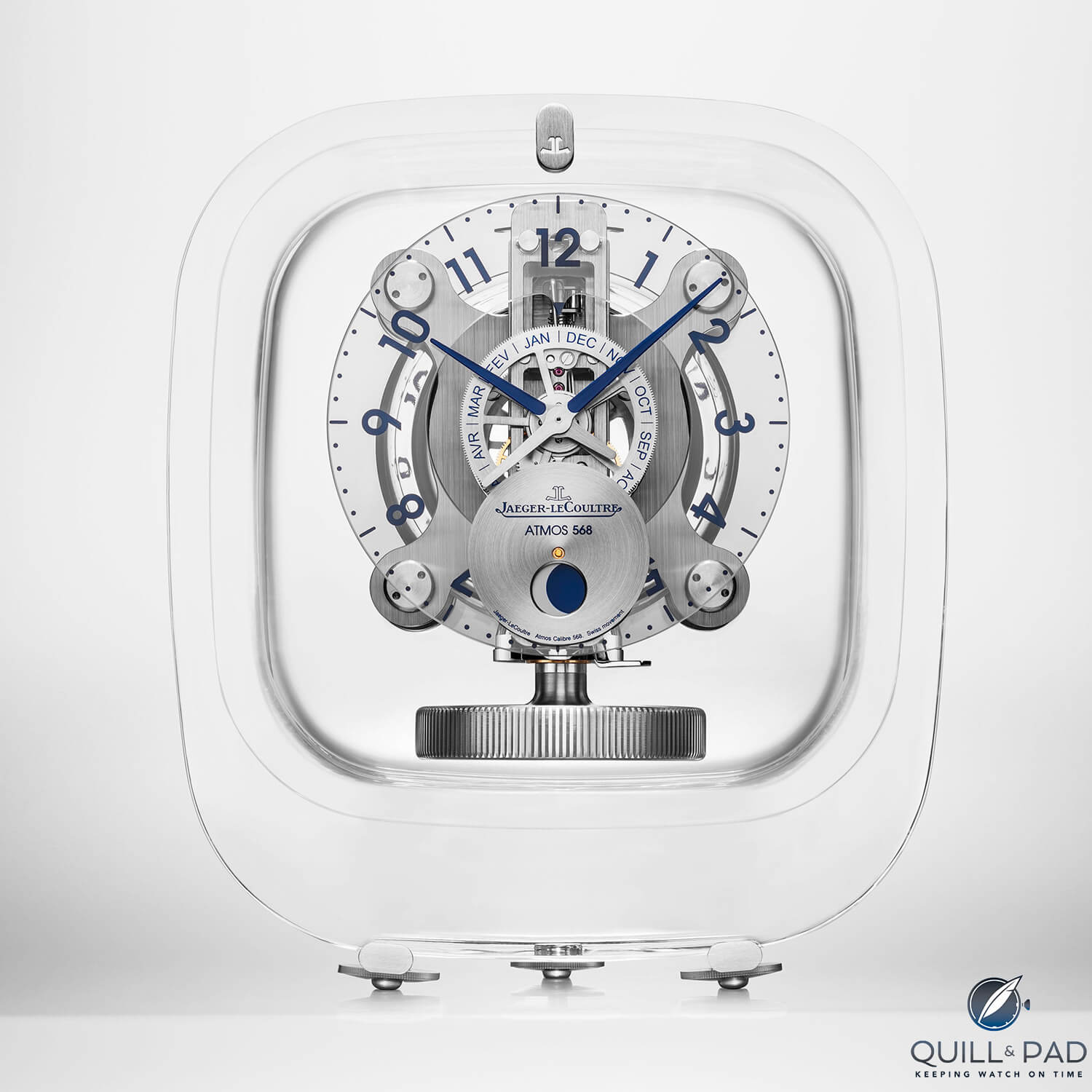
Jaeger-LeCoultre Atmos 568 by Marc Newson
How do you tackle the design of a truly iconic timepiece – even if you are celebrated designer Marc Newson?
“I think one of the most difficult things, potentially, about designing a watch, particularly an Atmos, or in fact designing a watch for a known company is that you’re dealing with quite an iconic object to begin with, an iconic brand that has been known for almost two centuries. The most challenging aspect of that is trying to interject your design elements but at the same time preserve the integrity of the object,” he explains.
First and foremost, it is an Atmos clock he reiterates, “So you need to be able to look at this object from 50 meters away and say, ‘that’s an Atmos.’ That remains the most important thing and one of the most important challenges for somebody like me, who’s coming from outside the industry, essentially, and has been entrusted to work with such an iconic brand and such a recognizable object.”
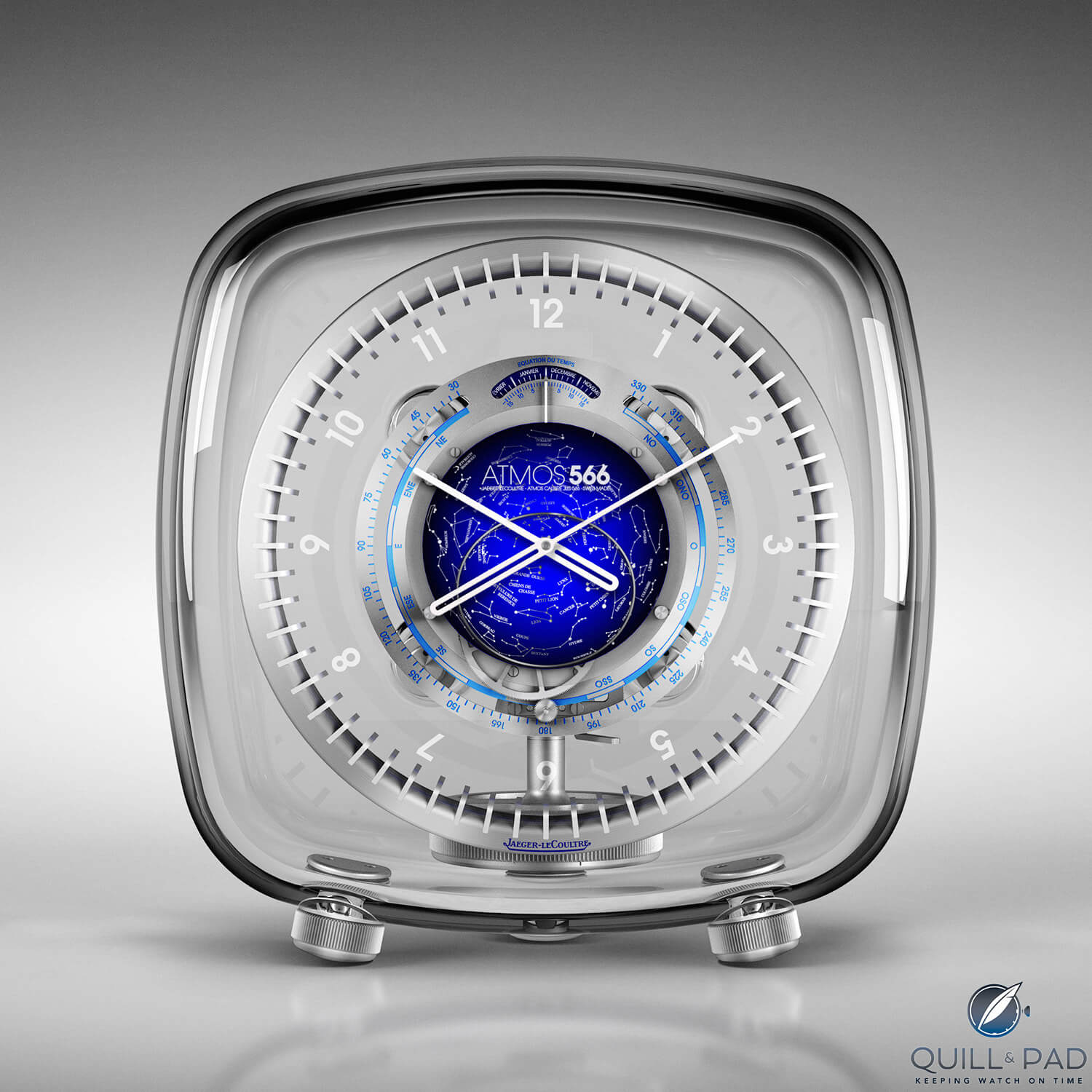
Light side of the Jaeger-LeCoultre Atmos 566 by Marc Newson from 2010
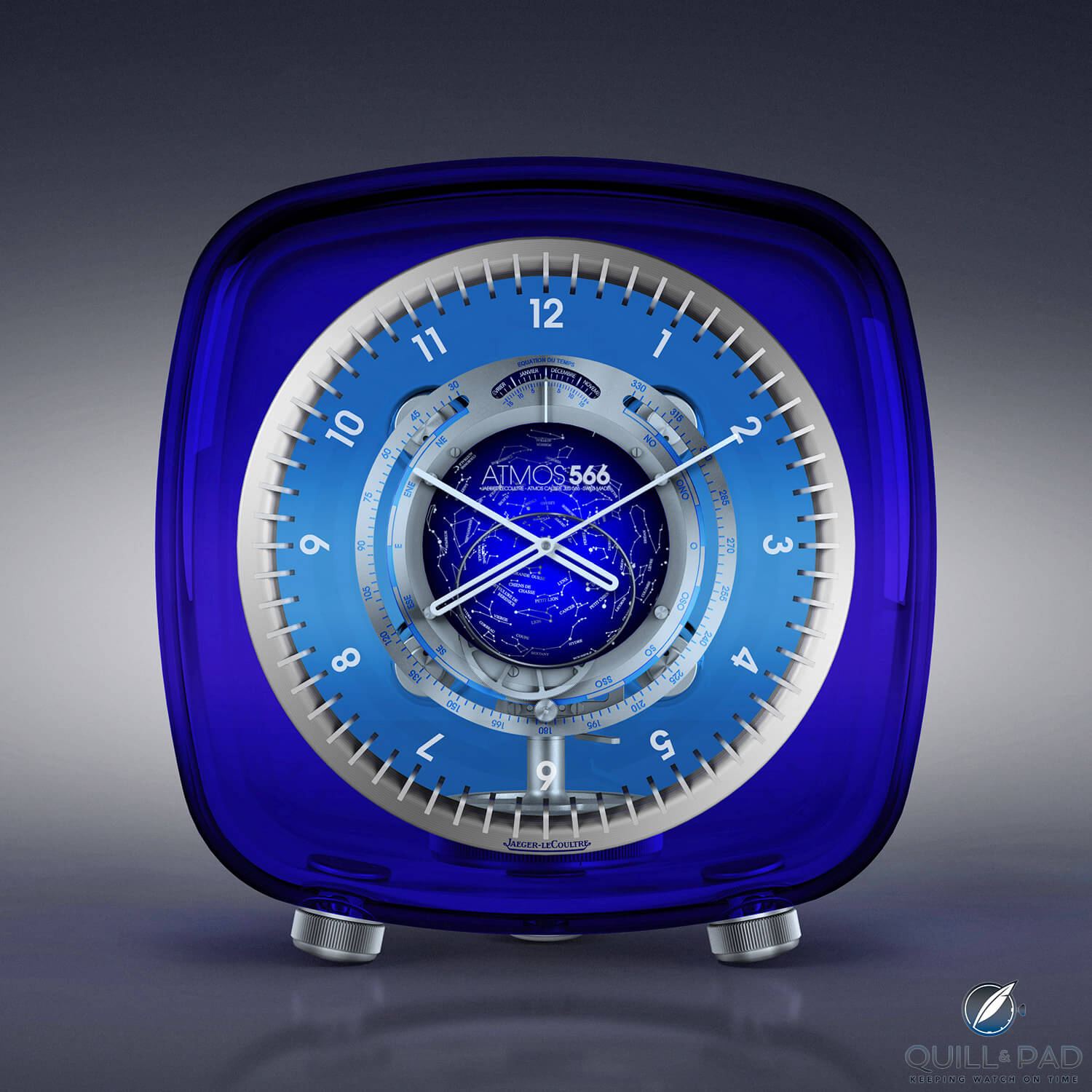
Blue side of the Jaeger-LeCoultre Atmos 566 by Marc Newson from 2010
Why Marc Newson keeps coming back to Jaeger-LeCoultre
Now having completed three clocks with Jaeger-LeCoultre as well as other projects within the world of horology (see Glass, Nostalgia, And The Ikepod Hourglass), it’s probably fair to say that at this point in his long career he could choose among pretty much any company with which to collaborate. So what is it about Jaeger-LeCoultre’s craft and aesthetic that keeps drawing him to the brand?
“Thus far my collaboration with Jaeger-LeCoultre extends to collaborating on Atmos clocks, so I suppose it’s in a sense limited to that,” he answers.
“However, I can say that it just sort of feels right. If you’re going to work with any brand, then I can’t think of a better one in this sector to work with. And it’s true that I don’t think I would want to necessarily work with anyone else. If you’re already working with the best, then why bother going elsewhere?”
He also states that because of the duo’s history together spanning almost a decade that it feels like sort of an evolutionary process. “At the risk of sounding presumptuous, I feel a history has developed between us – because it’s not always easy to work with anyone, and once you’ve established relations and you’ve proven that you can work together and indeed like working together, it’s often worth continuing.”
2017: Jaeger-LeCoultre Atmos 568
Newson’s exceptional Atmos 568 continues the theme of startling purity within a Baccarat crystal globe, paring it back and highlighting the sheer transparency to accentuate its essence.
“An Atmos for me is a complex and magical object, it seemingly runs on perpetual motion or the closest thing to it, and it needs a constant environment to function in. It is as if it is a living thing – you have the feeling that it can sense your presence – which I find strangely comforting.”

Making of the Jaeger-LeCoultre Atmos 568 by Marc Newson (photo courtesy Johann Sauty/Jaeger-LeCoultre)
And the 568 is all lightness, transparency, and simplicity; the movement appears to float freely in the air while actually being held in place by the rear part of its structure.
Its very simple dial is optimized for easy legibility with light passing right through the clear glass to illuminate it. The hands marking the passing time were chosen to echo the blue hue that Newson chose for the dial elements.
On the movement’s reverse, the mechanism is visibly held in place at four points, rather than the three on traditional Atmos clocks, to create symmetry. The unique membrane bridge, redesigned in a cross shape, showcases the bellows to great effect.
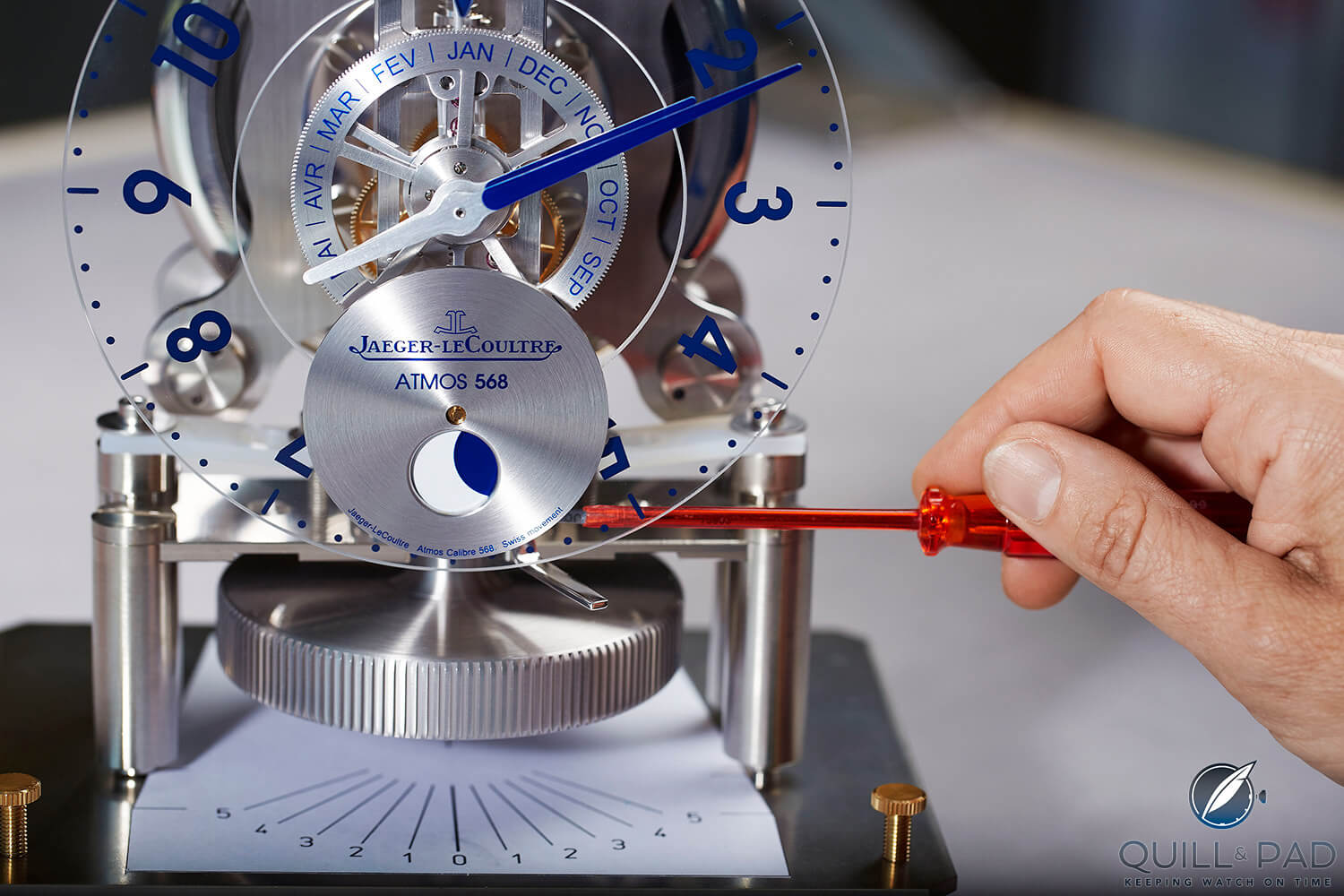
Making of the Jaeger-LeCoultre Atmos 568 by Marc Newson (photo courtesy Johann Sauty/Jaeger-LeCoultre)
The clock’s name is proudly emblazoned in the designer’s chosen blue on the back, while the his discreet signature is in his trademark orange.
The clear, rounded, cube-shaped cabinet housing the clock is of sophisticated elegance; Newson loves crystal for its aesthetic qualities and unique finish. And it is interesting to note that only a crystal manufacturer like Baccarat had the necessary technical expertise to create this casing; lengthy research was needed to reduce the crystal’s thickness to a minimum, a mere 13 mm in some places.
“Believe it or not, the glass took close to four years to figure out how to do,” Newson explains. “There’s a sheet of glass on the front that is removable so you can have access to what’s inside, but the rest is one piece, one big huge lump of glass, so you’ve really got to be able to work with it as if it were a liquid. That was incredibly technically complex and I will challenge anyone else to try and do it.”
“We exhausted many, many avenues all around the world with all sorts of different companies trying to achieve that,” Newson continues. “We ended up with one particular manufacturer, Baccarat, in France, who we had worked with before. That was really the most complex and technical part of the whole process, but of course, you look at it now and it doesn’t seem like such a big deal. And it is certainly very difficult to imagine why that would be so complex. There were many complex things but that was the most complex.”
One of the great challenges, he explained, was that glass is essentially liquid when it’s being formed, so it’s all about preserving the tolerances because it’s easy enough to take a big chunk of molten glass and pour it into a mold, but it’s what happens after that, during the cooling process, that is truly complicated to control. “So it’s really all about that, what happens after the forming has sort of taken place, and controlling and preserving the tolerances so that you end up with an object that can be repeated. Otherwise you’ll end up with something that is, you know, a little too unique.”
“Also, what may not seem completely obvious is that we’re using the glass as a completely structural material, so it not only houses the mechanism but it also holds and supports the mechanism.”

Marc Newson at the Jaeger-LeCoultre factory (photo courtesy Johann Sauty/Jaeger-LeCoultre)
Technology of the Atmos movement
Invented in 1928 by Jean Leon Reutter, the Atmos runs independently of human intervention thanks to a mixture of gases in a hermetically sealed capsule, which expands when the temperature rises and contracts when it falls. The capsule is connected to the clock’s drive spring and as it swells like the bellows of an accordion it winds the clock movement. A temperature fluctuation of a single degree Celsius is enough to provide the clock with energy for about two days. As the temperature changes, the gas expands or contracts, causing the carefully designed bellows to “breathe.”
The gear train of the Atmos, which beats twice a minute, is so perfectly designed that it requires no oil.
The breathing bellows push against a spring counterweight with chain. This counterweight drives a pinion to wind the mainspring a little bit at a time. The mainspring provides the minuscule amount of energy needed for the balance wheel (or torsion pendulum) to make its once-a-minute, back-and-forth cycle.
The pendulum hangs on a square Elinvar wire that produces a torsional force unlike the spiral force of a typical hairspring, which also allows for the extra-slow balance frequency.
At the end, I had a pretty general question for Newson, who’s worked with a variety of industries and designed hundreds, if not thousands, of different projects and objects: “If you were limited to one single object or category of objects, what would be your specialty choice?”
“Well,” he answered thoughtfully, obviously thinking hard. “What else can I say but timepieces? But in fact, it’s probably true; it’s one of the very first things that I wanted to design and started designing to the point where I attempted to create a company (the now-defunct Ikepod). I haven’t done that again, for anyone or anything else.”
You may also enjoy reading Choosing Your Favorite Flavor: Jaeger-LeCoultre Atmos 568 By Marc Newson.
For more information please visit www.jaeger-lecoultre.com/us/en/watches/atmos/atmos-by-marc-newson.
Quick Facts Jaeger-LeCoultre Atmos 568 by Marc Newson
Case: 265 x 230 x 147 mm, monobloc Baccarat glass cabinet designed by Marc Newson
Movement: Jaeger-LeCoultre Caliber 568, wound by temperature fluctuation in air, nearly perpetual, annular balance wheel, 120 vibrations per hour
Functions: hours, minutes; month, moon phase indication (one-day variation every 3,861 years)
Price: $26,800 excluding tax
Quick Facts Jaeger-LeCoultre Atmos 566 by Marc Newson
Case: 165 x 300 x 290 mm, monobloc Baccarat glass cabinet designed by Marc Newson
Movement: Jaeger-LeCoultre Caliber 568, wound by temperature fluctuation in air, nearly perpetual, annular balance wheel, 120 vibrations per hour
Functions: hours, minutes; month, equation of time, sky chart of Northern Hemisphere with zodiac
Limitation: 28 pieces in blue (Reference Q5165103) and 48 pieces in translucent glass (Reference Q5165102)
Price: €105,000 (blue), €90,000 (translucent)
Year of manufacture: 2010
Quick Facts Jaeger-LeCoultre Atmos 561 by Marc Newson
Case: 276 mm x 250 mm x 163 mm, monoblock Baccarat glass cabinet designed by Marc Newson
Movement: Jaeger-LeCoultre Caliber 561, wound by temperature fluctuation in air, nearly perpetual, annular balance wheel, 120 vibrations per hour
Functions: hour, minute; month, moon phase
Limitation: 888 pieces
Year of manufacture: 2008
Trackbacks & Pingbacks
-
[…] Click here to view original web page at quillandpad.com […]





















































Thank you so much for sharing this information here! I’d like to read more details about this innovative technology!
Thanks for reading! We’ll do our best to bring another in-depth on this amazing clock in 2018!
“undoubtedly the most exhilarating clock in the entire world” indeed!
I have been fascinated by the Atmos collection for years and this newest addition is no exception.
One iteration or another will eventually sit in my home I’m sure.
Great interview and a good read!
Hi Elizabeth. Thanks for that great article. Those Marc Newson Atmos clocks are the most gorgeous man made objects in the world.
But wait – what’s that on Marc’s wrist ? I’ve become so used to seeing Ikepods on Marc’s wrist in photos that I did a double take thinking “I’ve never seen that Ikepod model before…………”
Traitor……..?